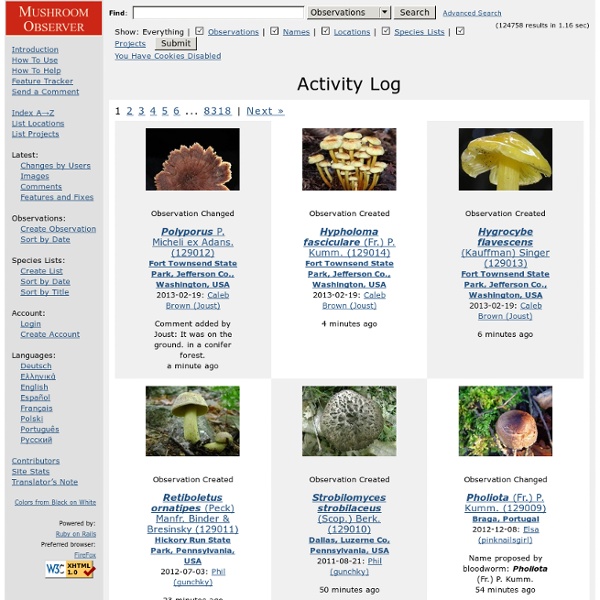



Encyclopedia of Earth Index Fungorum iPlant Collaborative Web Portal | The iPlant Collaborative: Empowering a New Plant Biology Checklist of the Mosses Mosses are the second most speciose group of plants, after the enormously richer angiosperms. A Checklist of Mosses lists 12,800 recognized species in 901 genera, including 42 synonymous genera with species that have not been transferred to the accepted genus. Each listed species is qualified using a four-level ranking system that indicates our level of knowledge about the species. Each in the highest three levels is supported by at least one citation from a bibliography of 1,756 references published since 1962, the closing date for the last comprehensive list of mosses, Index Muscorum. The Checklist, which is updated regularly (last update version February 2000), will be available on the web (the address is in the Introduction), and xerographic, strip-bound copies, about 300 pages, may be obtained, at cost plus shipping ($20.00), from the authors.
GIS and Mapping Resources « Writing for Nature I love maps. Maps tell convoluted stories in a seemingly simple, clean interface that belies the effort and planning that goes into constructing an understandable map. The one below is one I drew after working for several months in this particular portion of Ecuador, but it is only one of the many, many ways the area could be represented. Sketch Map of the region around Pucara in Intag, Ecuador During graduate school I was the TA for several courses where map making was one of the essential skills being taught, both old school with a compass and your stride length, and with the newer GIS methods. A good map, to me, is a work of art, it is something that you want to look at because it is interesting and beautiful on its own visual merits. This page has a partial list of some good mapping and GIS resources. The Weather and Climate page also has some GIS links. Keep in mind that within the US each state has a publicly accessible GIS clearing house, as do more and more cities. Hey What’s That?
Early Land Plants Today ucation Resources Information Center NotesFAQContact Us Collection Thesaurus AdvancedSearch Tips Privacy | Copyright | Contact Us | Selection Policy | API | Metrics Journals | Non-Journals | Download | Submit | Multimedia | Widget Flower-Visiting Insects Return to Illinois Wildflowers Click on links at right for specific insect visitors of plant species: Database Description Bird Database Bee Database Wasp, Ant, & Sawfly Database Fly Database Butterfly, Skipper, & Moth Database Beetle Database True Bug & Others Database Oligolectic Bees Database Abbreviations: Insect Activity Database Abbreviations: Scientific Observer Common Names: Insect Families Common Names: Insect Species Descriptions: Long-Tongued Bees Descriptions: Short-Tongued Bees Descriptions: Wasps Descriptions: Flies Descriptions: Beetles Descriptions: Plant Bugs Descriptions: Butterflies, Skippers, and Moths References Links Send comments or questions to Dr. The font size can be adjusted using the web browser controls.
Rupert Barneby Catalog The Barneby Catalogue The Barneby Legume Catalogue holds data from the subset of the legume collection that includes specimens of the 33 genera (see List on this page) that were monographed by the late, world-renowned taxonomist Rupert C. Barneby (1911-2000) and his collaborators, Howard S. Irwin and James W. Grimes, in "The Memoirs of the New York Botanical Garden." The Catalogue consists of three parts. The Barneby Genera The specimens of the Barneby genera in the Steere Herbarium provide unmatched geographical and taxonomic coverage of these genera. Support Funded in part by the National Science Foundation (DBI-0955567), Jacquelyn Kallunki, P.I., and Benjamin Torke and Melissa Tulig, Co-P.I.s This material is based upon work supported by the National Science Foundation under Grant Number (DBI-0955567).
California Seaweed eFlora Understanding the consequences of global climate change and anthropogenic alteration of the marine environment The California coastal environment has suffered from the consequences of rapid population growth: alteration or degradation as the result of development, pollution, overfishing, oil drilling, mariculture and global marine transportation. Habitats for seaweeds, especially in southern California, are vastly different than they were 100 years ago. We know that biological consequences of global climate changes in the Pacific marine environment will be broad-reaching. Updating taxonomic concepts and biogeography Our understanding of the California's seaweed flora has changed dramatically since the publication of Marine Algae of California (1976). Since 1976, 105 taxa have been added to the flora and 300 names have changed. Fostering education There is a pressing need for assistance in identifying California seaweeds. George F.
Plankton Portal World data centre for microorganisms: an information infrastructure to explore and utilize preserved microbial strains worldwide + Author Affiliations ↵*To whom correspondence should be addressed. Tel: +86 10 64807422; Fax: +86 10 64807426; Email: ma@im.ac.cn ↵†These authors contributed to the paper as First Authors. Received August 13, 2016. Revision received September 24, 2016. Accepted September 30, 2016. Abstract The World Data Centre for Microorganisms (WDCM) was established 50 years ago as the data center of the World Federation for Culture Collections (WFCC)—Microbial Resource Center (MIRCEN). Microbial resources are essential to understand and develop life sciences because microorganisms are crucial to maintain the external environment as well as the inner ecosystem of humans, higher animals and plants. The World Federation for Culture Collections (WFCC) is a COMCOF (Committees, Commissions and Federations) of the International Union of Microbiological Societies (IUMS) and a scientific member of the International Union of Biological Sciences (IUBS). Figure 1. CCINFO serves as a metadata recorder. Impact